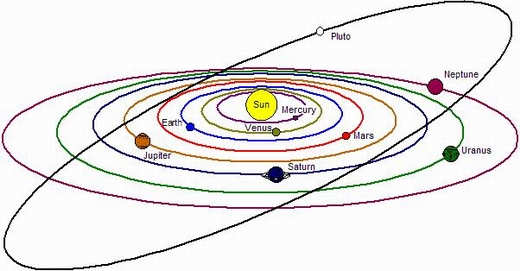

 字體:小 中 大
字體:小 中 大 |
|
|
|
| 2006/08/25 17:30:27瀏覽2253|回應3|推薦22 | |
國際天文聯合會 (IAU) 大會今天推翻了一周前「行星定義委員會」提出的草案,而通過了一個新的「行星新定義」,給行星多加了一個限制,因此太陽的行星 (planet) 確定只剩下八個了。(參考行星新定義) 坦白說,這個結論有點令人失望。不是冥王星降級令人失望,而是新的定義令人失望。 新新定義是這樣的:「1, 行星是在軌道上繞行恆星的星體;2, 擁有足夠的質量,因此本身的重力可以克服剛體的力量,而成為近似球形的形體;3, 公轉的軌道未與其它行星軌道交會。」 關於第三點,原文是這樣的:has cleared the neighbourhood around its orbit. 字面的意思有點模糊,但是就因為這一條,把冥王星除名了,因為冥王星的軌道插入了海王星的軌道內。(也就是說,有的時候,冥王星會比海王星靠近太陽,如上圖。) 冥王星不再是行星之後,被歸類為矮行星 (dwarf planet)。同類的,還有榖神星 (Ceres) 和齊娜 (2003UB313)。先前被提到的冥衛一卡倫(夏龍 Charon) 沒有列入,難道又把卡倫視為冥王星的衛星了嗎?真是數日一變! 這類星體的名稱是矮行星,矮是質量小或昏暗的意思。這些星體不能成為行星的主因,就是因為它們太小。可是,關於行星和矮行星的定義,在大小上的要求居然是一樣的;區隔二者的關鍵,只因為後者 has not cleared the neighbourhood around its orbit,真是欲加之罪何患無詞啊! Dwarf star 是 star,dwarf galaxy 是 galaxy,唯獨 dwarf planet 不是 planet!(白牛是牛,白狗是狗,唯獨白馬非馬!) 今天的決議還把繞行太陽的較小星體稱作「太陽系小星體」(small solar-system bodies),適用於為數眾多的小行星 (asteroids)、彗星 (comets)、外海王星天體 (Trans-Neptunian Objects) 及其他小星體。 (參考《航向冥王星》) 今天通過的三類星體的定義如下: (1) A "planet"1 is a celestial body that (a) is in orbit around the Sun, (b) has sufficient mass for its self-gravity to overcome rigid body forces so that it assumes a hydrostatic equilibrium (nearly round) shape, and (c) has cleared the neighbourhood around its orbit. 1The eight planets are: Mercury, Venus, Earth, Mars, Jupiter, Saturn, Uranus, and Neptune. 2An IAU process will be established to assign borderline objects into either dwarf planet and other categories. 3These currently include most of the Solar System asteroids, most Trans-Neptunian Objects (TNOs), comets, and other small bodies |
|
| ( 知識學習|科學百科 ) |












